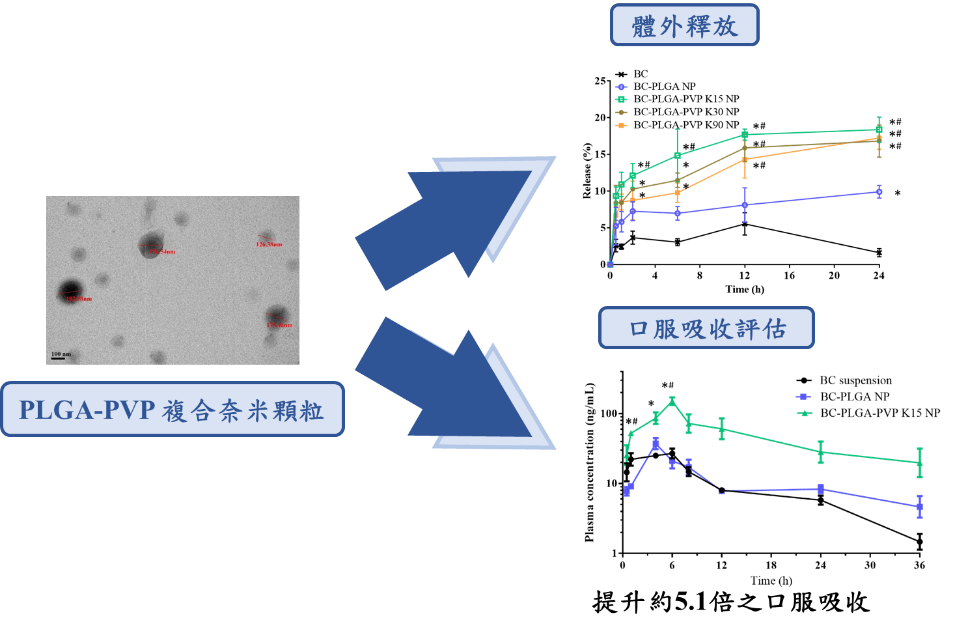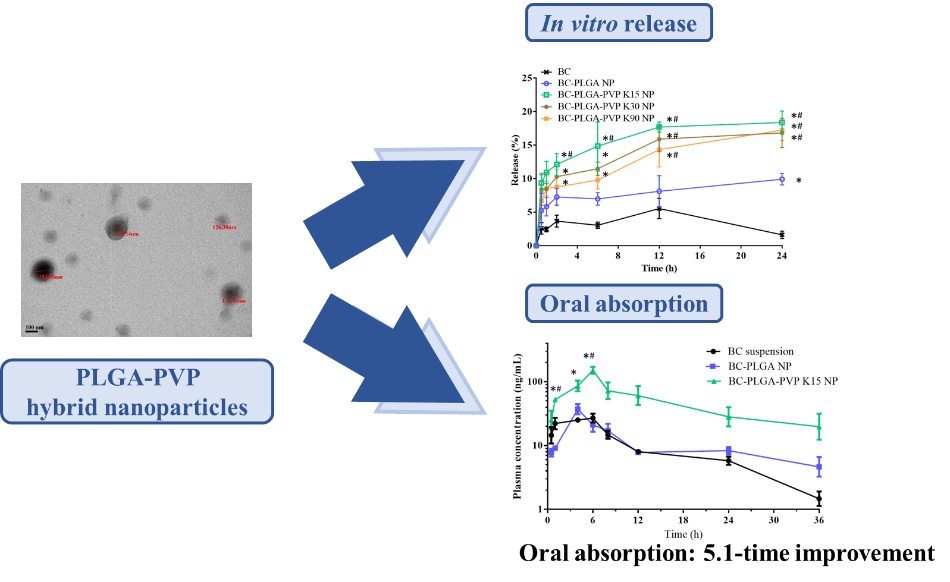開發複合奈米顆粒以提升難溶性化合物之口服吸收率
開發複合奈米顆粒以提升難溶性化合物之口服吸收率
口服為目前最方便且常見的給藥途徑之一,由於藥品或天然物活性成分具有不同的物化性質,例如:溶解度(Solubility)及穿透度(Permeability),往往造成口服吸收程度之極大差異,進而造成功效的不確定性。文獻指出目前已上市之西藥或處於開發中新藥,大部分皆屬於低溶解度或低穿透度之成分,這些特性將導致極差之口服吸收率,亦造成無法達到預期功效的情況發生。許多在細胞試驗具有極佳活性之化合物,往往也因為口服吸收不佳,導致在動物實驗時呈現的效果不如預期。因此如何改善活性成分之口服吸收是一關鍵的研究課題。以日常飲食中常見成分β-胡蘿蔔素為例,本身具有優異的抗氧化活性,以及多樣的藥理活性,然而其水溶性不佳(Log P = 17.62,在水中溶解度為0.6 mg/L),且對於光、熱及氧氣均不安定,因此會大幅影響β-胡蘿蔔素之口服吸收率。
本研究以聚乳酸甘醇酸(Poly lactic-co-glycolic acid, PLGA)和聚乙烯吡咯烷酮(Polyvinylpyrrolidone, PVP)製備複合奈米顆粒,包覆β-胡蘿蔔素用於口服傳輸以提升其水溶解度。運用聚乳酸甘醇酸製成奈米顆粒,是改善難溶性成分之溶解度、口服吸收率的有效策略。聚乳酸甘醇酸是由乳酸和甘醇酸構成之聚合物,具有極佳的生物相容性及生物可降解性,然而其溶蝕速率慢,使得藥品/活性成分之釋出過於緩慢,是應用於口服傳輸時的缺點,因此本研究添加水溶性聚合物聚乙烯吡咯烷酮製成包覆β-胡蘿蔔素之複合型奈米顆粒。實驗結果顯示,相較於單純使用聚乳酸甘醇酸,加入親水性較佳的聚乙烯吡咯烷酮後,複合型奈米顆粒具有較小的粒徑,於15分鐘時能提升β-胡蘿蔔素的釋放達2.26倍,可提升離體大鼠腸道穿透度達2倍。由大鼠之藥物動力學實驗發現,聚乳酸甘醇酸奈米顆粒提升β-胡蘿蔔素之相對口服生體可利用率為113.3%,而複合型奈米顆粒可顯著提升達508.7%。此劑型除可藉由奈米粒徑促進β-胡蘿蔔素被腸道M cell吸收,添加之聚乙烯吡咯烷酮,具有成孔劑之角色而加速聚乳酸甘醇酸之溶蝕。此外,聚乙烯吡咯烷酮亦具有界面活性劑、防止活性成分再結晶析出、降低腸胃道中膽鹽之臨界微胞濃度及調節外排蛋白、代謝酵素之特性,藉由上述這些機制提升了β-胡蘿蔔素之口服吸收率。因此複合型奈米顆粒可作為難溶活性成分的有效口服傳輸策略。本研究於今(2022)年3月發表於國際學術期刊(Pharmaceutics)。

【應用與亮點】
1.日常飲食中常見成分─β-胡蘿蔔素雖然具有相當優異的抗氧化活性及藥理作用,但水溶解度差及安定性不佳顯著影響其口服吸收,因此改善水溶解度對於口服吸收和功效發揮具極大作用。
2.本研究以親水性聚合物「聚乙烯吡咯烷酮」和「聚乳酸甘醇酸」,製作複合型奈米顆粒,有效提升β-胡蘿蔔素之釋出以及腸道穿透性。
3.由大鼠之藥物動力學實驗證實此劑型可提升β-胡蘿蔔素口服吸收達5倍。
【研究團隊】
團隊成員:吳育澤、劉宛怡、謝昀珊
代表單位:高雄醫學大學藥學系
團隊簡介:本研究團隊致力於針對低水溶解度或低穿透度之活性化合物進行劑型設計及開發,改善其口服生體可用率,以進一步提升功效。
研究聯繫Email:ytwu@kmu.edu.tw
【論文資訊】
論文出處:Pharmaceutics. 2022 March; 14 (3): 637.
全文下載:https://www.mdpi.com/1999-4923/14/3/637
Development of hybrid nanoparticles to improve the oral absorption efficiency of poorly soluble compounds
Development of hybrid nanoparticles to improve the oral absorption efficiency of poorly soluble compounds
Oral administration is one of the convenient and common routes. Due to the different physicochemical properties of natural products, such as solubility and permeability, which makes the significant absorption variation and the unexpected therapeutic efficacy. Previous studies indicated that most of the marketed medicines or new drug candidates in the developing phases have low solubility and permeability characteristics, which will lead to extremely low oral absorption, and fail to achieve the expected efficacy. Many compounds, which performed excellent bioactivities in cell assay, often showed less efficacy in animal models due to the poor aqueous solubility of the compounds. Therefore, to improve the oral absorption of active ingredients is a essential research topic. Taking β-carotene, a commonly ingredient in foods for example, it has excellent antioxidant activity and various pharmacological activities, but its aqueous solubility is poor (Log P = 17.62 and solubility in water is 0.6 mg/L). Furthermore, it is unstable when exposed to light, heat and oxygen, which greatly affect the oral absorption of β-carotene.
In this study, hybrid nanoparticles were prepared with poly lactic-co-glycolic acid (PLGA) and polyvinylpyrrolidone (PVP) to encapsulate β-carotene for the oral delivery to improve aqueous solubility. The use of PLGA nanoparticles is an effective strategy to improve the solubility and oral absorption of poorly soluble compounds. PLGA is a polymer composed of lactic acid and glycolic acid, and has excellent biocompatibility and biodegradability. However, its erosion is too slow to provide sufficient release in a short time. Due to this disadvantage, water-soluble polymer, PVP, was added to PLGA nanoparticles to prepare β-carotene-loaded hybrid nanoparticles. The results showed that the hybrid nanoparticles added hydrophilic PVP had a smaller particle size and improved the release of β-carotene for up to 2.26 times at 15 min compared to the PLGA nanoparticles. Furthermore, the hybrid nanoparticles had 2-times increase for intestinal permeability. In the pharmacokinetic study, the relative oral bioavailability improved by the PLGA nanoparticles was 113.3%, while the relative oral bioavailability improved by the hybrid nanoparticles was increased to 508.7%. The absorption improvement of β-carotene could be attributed to be absorbed by the M cells through the nanoscale particle size. Furthermore, PVP in hybrid nanoparticles plays the role of porogen and accelerates the erosion of PLGA. In addition, PVP is also a surfactant, an inhibitor of recrystallization and precipitation, a reducer of critical micelle concentration in the gastrointestinal tract, and a modulator of efflux and metabolic enzymes. Thus, these factors may contribute to the increased oral absorption of β-carotene. To sum up, the hybrid nanoparticles can be an effective oral delivery strategy for poorly soluble compounds. This article has been published in the Pharmaceutics in March 2022.
Graphical Abstract

Application and Highlights:
1.Although β-carotene, a commonly ingredient in foods, exhibits excellent antioxidant activity and health-promoting effects, poor aqueous solubility and stability greatly limits its oral absorption. Therefore, to improve the aqueous solubility is a very important issue for enhancing its oral absorption efficacy.
2.In this study, the hydrophilic polymer "polyvinylpyrrolidone" and "poly lactic-co-glycolic acid" were used to prepare hybrid nanoparticles, which can effectively improve the in vitro release of β-carotene and intestinal permeability.
3.The pharmacokinetic study also confirmed that hybrid nanoparticles have led to a 5-time enhancement for the oral absorption of β-carotene.
Research Team Members: Yu-Tse Wu, Wan-Yi Liu, and Yun-Shan Hsieh
Representative Department: School of Pharmacy, College of Pharmacy, Kaohsiung Medical University
Introduction of Research Team: We are committed to the formulation design and development of active compounds with the properties of low aqueous solubility or low permeability to improve their oral bioavailability. At present, a variety of active compounds (including flavonoids, carotenoids, and lignans) have been investigated.
Contact Email: ytwu@kmu.edu.tw
Publication: Pharmaceutics. 2022 March; 14 (3): 637.
Full-Text Article: https://www.mdpi.com/1999-4923/14/3/637


